So far, most of the changes in Asia have been driven by governments, large institutions, and enterprises, while mass market services aimed at ordinary consumers are still in their early stages.
Written by: Tiger Research Reports
Translated by: Deep Tide TechFlow
Key Summary:
The Web3 market in Asia is rapidly growing, thanks to a tech-savvy population, proactive government policies, and widespread corporate participation. Major countries like South Korea, Japan, and Vietnam are leading the trend.
- New regulatory frameworks in South Korea, Indonesia, and Thailand are promoting blockchain innovation, with sandbox regulations encouraging experimentation in real-world assets (RWAs), decentralized finance (DeFi), and digital asset services.
- Emerging markets like China and Cambodia are filled with opportunities but also come with risks. Despite regulatory challenges, unofficial participation in China remains significant, while Cambodia offers growth potential for small and medium-sized enterprises willing to navigate legal complexities.
1. Tiger Research's Focus on Asia
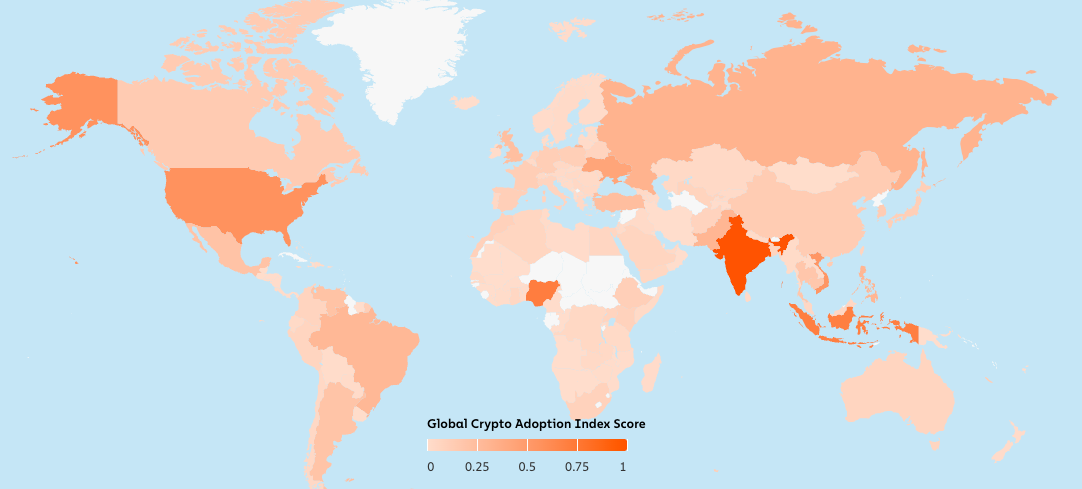
Source: Chainalysis
At Tiger Research, we focus primarily on the Web3 market in Asia due to its immense potential and rapid growth. Asia stands out for several reasons: 1) a young and tech-savvy population, 2) high levels of technology adoption, 3) well-established regulatory frameworks, and 4) an aggressive corporate attitude. These factors are driving Asia to become a leading force in the global Web3 space. Among the many countries in the region, we are currently focusing on the following key markets:
- South Korea: Enterprise-level companies are entering the Web3 space, with blockchain game development taking a significant position. Major gaming companies are actively preparing for the launch of blockchain games, marking a shift in the industry.
- Japan: Government-led initiatives are revitalizing the Web3 industry and promoting active corporate participation. Major companies with global IPs, such as Sony and Bandai Namco, are expected to make significant contributions.
- Indonesia: With its large population and rapidly growing market, Indonesia has considerable long-term potential. The government's proactive stance, including the launch of a state-owned cryptocurrency exchange, further enhances this outlook.
- Vietnam: Vietnam is poised to become a "Web3 powerhouse" in Asia, thanks to high levels of technology adoption among its young population and a competitive developer community.
- Thailand: The government, financial sector, and public in Thailand are highly engaged in the crypto market. Traditional financial institutions are leading the way in Web3 initiatives.
- Singapore: Despite having a clear regulatory framework and sandbox projects that promote innovation in ICOs, STOs, RWAs, and payments, reduced corporate support poses challenges.
- India: With its vast talent pool and thriving startup ecosystem, India has immense potential in the Web3 space. Success stories like Polygon highlight India's capability to drive global Web3 infrastructure projects. These countries are leveraging their unique strengths to shape the future of the Asian Web3 market. Monitoring developments in these countries in the third quarter will provide valuable insights into emerging trends and opportunities in the Asian Web3 space.
2. New Regulatory Frameworks
2.1. South Korea: Questions About the Bill's Effectiveness
On July 19, 2024, South Korea introduced the "Virtual Asset User Protection Act" to enhance investor protection and ensure market integrity. Key provisions of the bill include: 1) a clearer definition of virtual assets, 2) mandatory interest payments on customer deposits, 3) insurance requirements in the event of incidents, 4) strengthened regulation of unfair trading, and 5) unconditional penalties for market manipulation (MM) behavior.
One of the most direct impacts has been that major exchanges like Upbit and Bithumb have begun competing to offer interest rates of 2-4% on customer deposits. Additionally, token issuance projects are strengthening internal controls to comply with the new regulations.
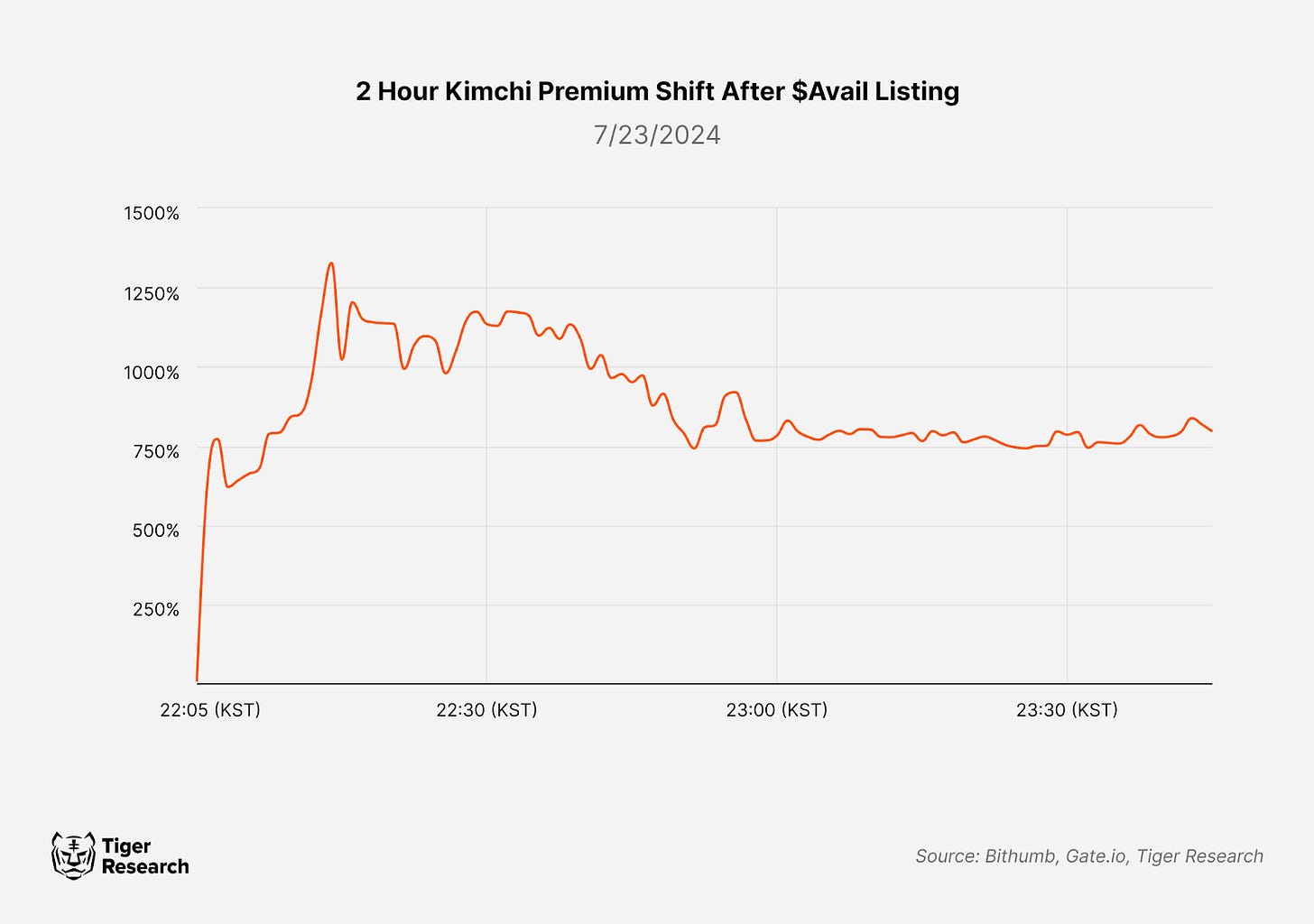
Source: Bithumb, Gate.io, Tiger Research
However, the $AVAIL case has raised questions about the bill's effectiveness. Reports indicate that arbitrage trading generated profits of about 1 billion won due to significant price differences between domestic and global exchanges. This highlights ongoing issues such as price manipulation and market disruption, but the lack of thorough investigations has led to doubts about the bill's actual impact.
2.2. Indonesia: Implementing a Blockchain Technology Sandbox
In June 2024, the Financial Services Authority of Indonesia (OJK) introduced a sandbox framework under Regulation No. 3/2024 on Financial Sector Technological Innovation (POJK 3/2024). This regulation covers a wide range of blockchain-related technologies and is expected to bring previously unregulated financial services into the official system.
Key areas of focus include virtual asset services such as staking and stablecoins, which now have the opportunity to be tested within a regulatory framework and potentially gain recognition. The sandbox is expected to promote the development of new financial services, particularly at the intersection of blockchain and traditional finance, as well as the tokenization of real-world assets (RWAs). These innovations are anticipated to revolutionize Indonesia's financial market.
The on-site inspections indicate that the new regulations are being actively used for market supervision. Looking ahead, we will continue to assess the effectiveness of these regulations and track market responses to ensure the sustainable growth of South Korea's virtual asset market.
The sandbox regulations reflect the Indonesian government's proactive attitude in supporting financial innovation while ensuring consumer protection and market stability. This initiative is expected to further accelerate the growth of Indonesia's fintech industry.
Participating companies must meet specific criteria, such as demonstrating innovative and unique services for Indonesian consumers and businesses. Additionally, they must submit the necessary documentation to the OJK during the application process. Approved companies will have one year to test their services, and after evaluation, they will have six months to obtain a full license. This balanced approach provides companies with the flexibility to enter the market quickly while ensuring sufficient time to experiment and optimize their services.
2.3. Thailand: Sandbox Regulations Extended to Real-World Asset Market
The Securities and Exchange Commission (SEC) of Thailand has taken significant steps to promote innovation in the digital asset and Web3 space. In August 2024, the SEC launched a digital asset sandbox to complement its existing detailed licensing framework. This sandbox allows for testing key initiatives aligned with emerging market trends.
The sandbox provides space for experimentation in various areas, including the tokenization of real-world assets (RWAs), payment systems, security protocols, and decentralized finance (DeFi). Bitkub Academy, a subsidiary of the cryptocurrency exchange Bitkub, expressed optimism about this, viewing it as a great opportunity for entrepreneurs to test innovative ideas within a legal framework.
This initiative is also expected to directly benefit users, allowing them to experience new features and products in the digital asset and Web3 space. A typical example is RealX, Thailand's first tokenized real-world asset, which was listed on the Bitkub exchange due to the SEC's open attitude towards innovation.
Looking ahead, as new possibilities emerge in Thailand's digital asset market, more groundbreaking projects are expected to arise. At the same time, the establishment of clear and comprehensive laws and regulations is anticipated to enhance market stability. Thailand's proactive attitude will play a key role in shaping the future of the country's digital asset ecosystem.
3. New Government Initiatives
3.1. India: National Blockchain Framework (NBF)
On September 4, 2024, the Indian government launched the National Blockchain Framework (NBF), marking a significant step in the country's digital transformation strategy. The NBF is not only about the adoption of technology; it represents an ambitious plan to build a more secure and efficient digital infrastructure by addressing the limitations of traditional systems in India's rapid digitalization process.
Several key objectives of the NBF include: enhancing transparency in the public sector, combating corruption, promoting technological innovation, and driving economic growth. Additionally, the plan aims to improve citizen-centric services. By leveraging the immutability and transparency of blockchain, the NBF aims to enhance the reliability of government transactions and records. Its goal is to make data manipulation more difficult and increase citizens' trust in government systems.
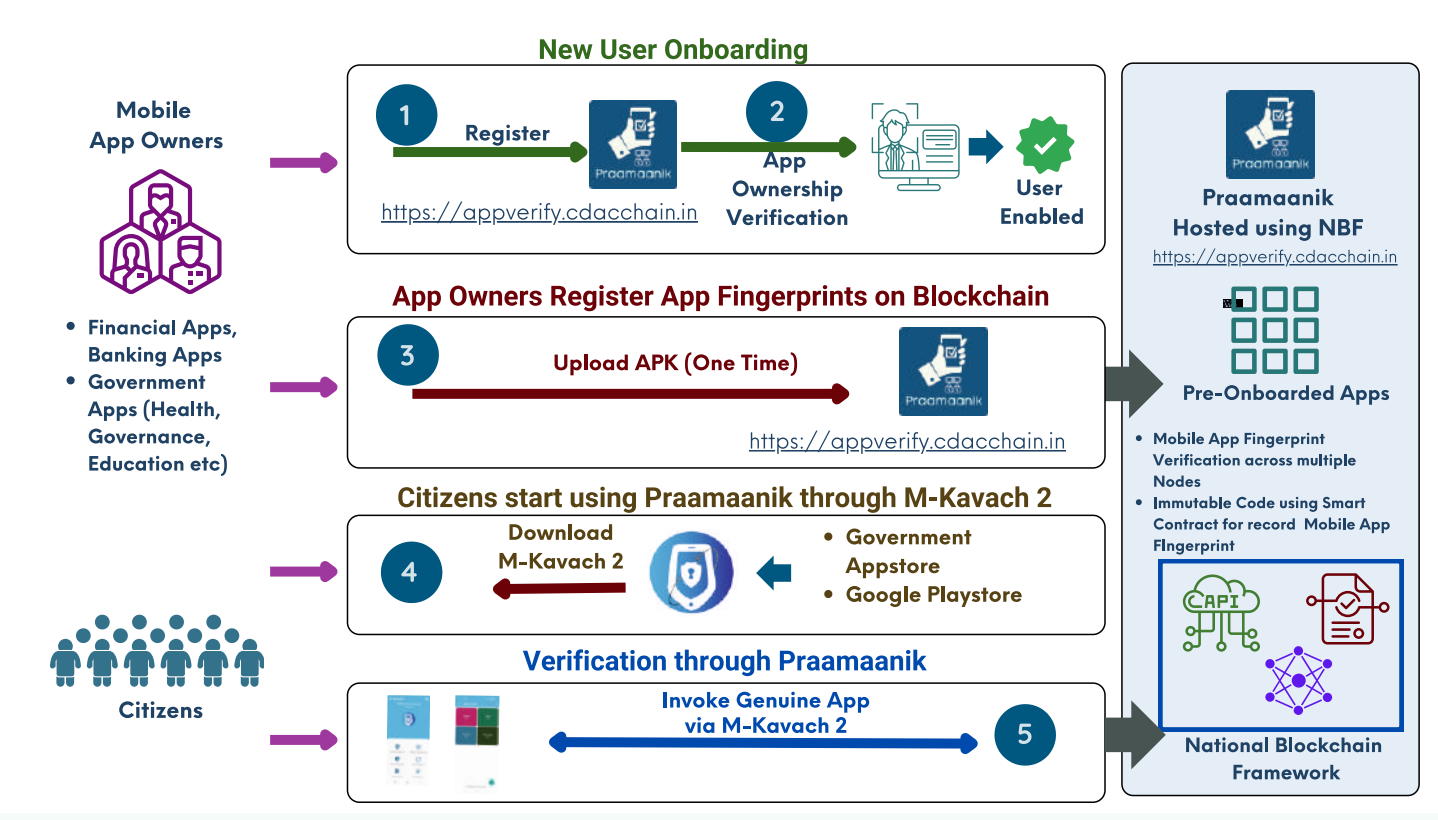
Praamaanik, Source: NBF-brochure
Key components of the NBF include:
- Vishvasya Blockchain Technology Stack: As a blockchain-as-a-service (BaaS) solution, it provides decentralized infrastructure that enables startups and enterprises to quickly develop blockchain-based new services. The technology stack aims to accelerate the adoption of blockchain in both the public and private sectors by leveraging government data.
- NBFLite: This is a lightweight blockchain platform designed for startups and academia, supporting rapid prototyping, research, and education, aimed at fostering blockchain innovation and talent development in India.
- Praamaanik: This is a blockchain solution for mobile application source verification, enhancing the security of India's mobile ecosystem by preventing the spread of malicious or counterfeit applications, thereby increasing user trust and system integrity.
- National Blockchain Portal: This comprehensive platform provides the latest information on blockchain technology, including news, events, and educational resources. Its goal is to raise public awareness and increase access to blockchain knowledge.
India's NBF is one of the few state-led initiatives globally that supports blockchain technology across multiple industries. It views blockchain as critical infrastructure and has the potential to transform the country's digital landscape. If successful, the NBF could serve as a model for other countries, demonstrating how to integrate blockchain into national infrastructure.
4. Enterprise-Driven Market
4.1. Japan: Financial Sector-Led Blockchain Ecosystem
As previously reported, Japan's blockchain ecosystem is still influenced by the financial sector. A significant recent development is Sony's collaboration with blockchain company StarTale to launch a new Ethereum Layer 2 solution called Soneium, officially entering the blockchain space. Soneium was released in August 2024 and aims to leverage Sony's extensive global influence and user base to provide scalable infrastructure for Web3 applications.

Source: Soneium
Sony has also launched an incubation program called Soneium Spark, which provides developers with infrastructure, guidance, industry partnerships, and funding support of up to $100,000. This initiative follows Sony Bank's announcement of plans to launch a yen-backed stablecoin, further indicating Sony's increasing involvement in the Web3 ecosystem and its active exploration of new opportunities in blockchain technology.
Currently, Soneium is in the testing phase called Minato, with the mainnet expected to launch in the first quarter of 2025. The platform is attracting attention, with reports of over 50 projects being developed or planned for deployment on Soneium. This marks a significant step for major tech giants entering the blockchain space, especially against the backdrop of financial companies primarily creating their own blockchains. The success of Soneium could be a key step towards broader adoption and promotion of blockchain technology by large enterprises.

Source: Ishiba
On the political front, Japan is also undergoing significant changes. Ishiba is expected to become the next Prime Minister, and he belongs to the same Liberal Democratic Party as the current Prime Minister Kishida. However, his stance on the blockchain market remains unclear. Although Ishiba's policy proposals include plans to utilize blockchain and NFT technology to revitalize rural areas, this initiative primarily focuses on regional development rather than promoting the broader blockchain industry. It remains to be seen how Ishiba's policies will impact Japan's blockchain sector once he forms his cabinet.
4.2. Vietnam: Education and Industry Synergy in Developing the Blockchain Ecosystem
Vietnam's blockchain ecosystem is rapidly growing, thanks to the strategic synergy between education and industry development. At the core of this progress are the efforts of the Vietnam Blockchain Association (VBA) and the Blockchain and AI Innovation Institute (ABAII).
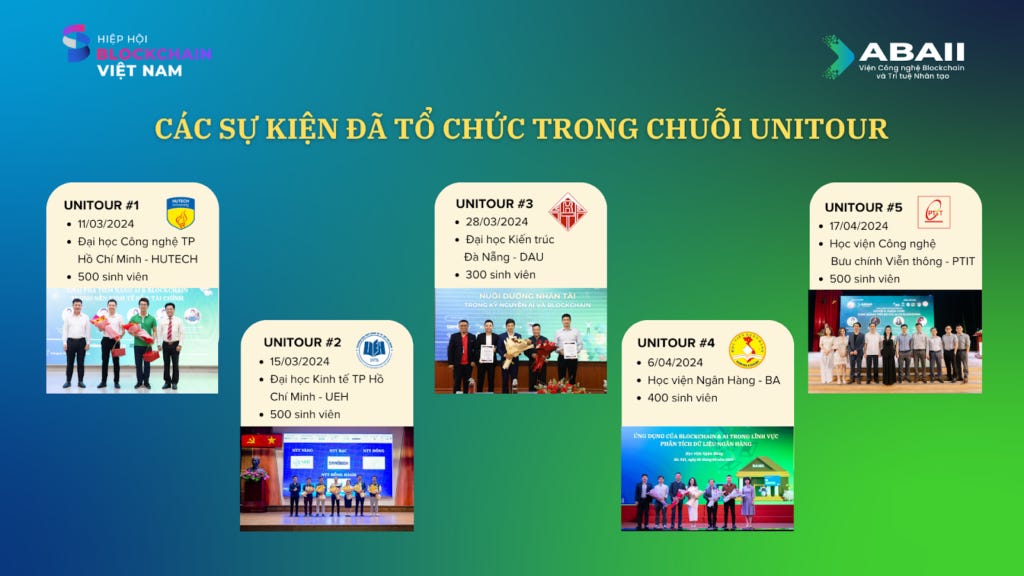
Source: ABAII
The VBA has partnered with Tether to hold educational conferences in major cities in Vietnam. Additionally, the VBA collaborates with ABAII to provide blockchain education to university students through its UniTour program, a series of university visits aimed at sparking interest in blockchain technology. Beyond education, the VBA has played a key role in helping students and young professionals enter the blockchain industry. One noteworthy initiative is the SwitchUp Accelerator program, which offers guidance, support, and investment to Web3 startups and projects.
Since its official launch on January 10, 2024, ABAII has initiated an active educational promotion campaign. ABAII has received certification from the Ministry of Science and Technology and is supported by the VBA, aiming to become a leading center for blockchain research, development, and application in Vietnam. Its long-term goal is to provide blockchain education to one million Vietnamese people by 2030. In the short term, ABAII plans to train 100,000 students across 30 universities.
This coordinated approach of combining education with startup incubation lays a solid foundation for the sustainable growth of Vietnam's blockchain industry. With a clear strategy, Vietnam is striving to become a significant player in the global blockchain market.
5. New Countries to Watch in the Blockchain Market
5.1. China: Will the Market Open Up?

Source: X @justinsuntron
Despite facing strict regulatory crackdowns in 2017 and 2021, China's cryptocurrency market remains active behind the scenes. While the official stance on opening the market is poor, there is still a lot of activity and enthusiasm among builders and investors.
Chinese entrepreneurs continue to seek ways to participate in the global blockchain ecosystem, such as engaging in international projects and establishing overseas subsidiaries. Large capital from China remains a powerful force in the market, even if it is not reflected in official statistics. Chinese investors are still actively involved, contributing to the growth of the crypto market.
The existence of a gray market is another notable feature. Despite government bans, trading continues through peer-to-peer and offshore exchanges. This phenomenon indicates that regulatory measures alone have not completely halted activity.
While it is unlikely that China will formally reopen its cryptocurrency market in the short term, its technological strength and capital influence in the global blockchain ecosystem cannot be ignored. If China opens its market, the impact will be profound. However, even without an official market, China has played a significant role in shaping the global cryptocurrency landscape.
It is crucial to closely monitor regulatory changes and market dynamics in China, as developments there may still be key factors in the evolution of the global blockchain industry.
5.2. Cambodia: A Market of Risks and Opportunities
Cambodia's cryptocurrency market has recently attracted attention, but not for optimistic reasons. In August 2024, Huione Guarantee was embroiled in a major scandal, accused of being involved in illegal transactions worth $49 billion. As a result, reports about Cambodia's cryptocurrency market have largely focused on crime and fraud.
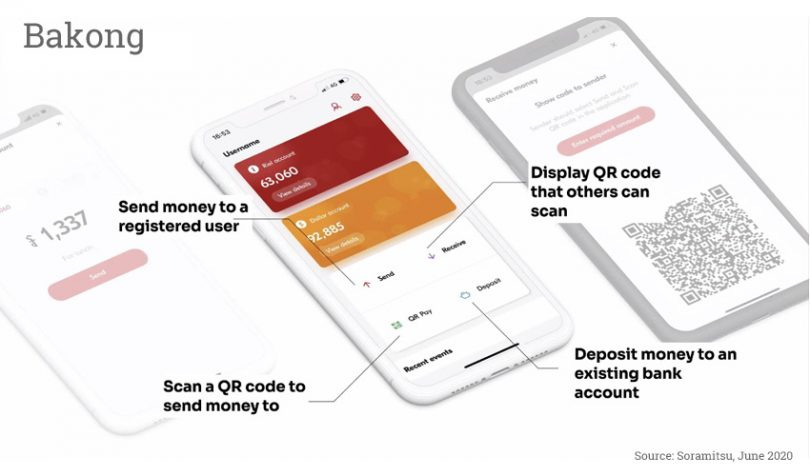
Source: Soramitsu
However, Cambodia's blockchain development is not solely defined by recent turmoil. Until 2022, the Cambodian government was actively exploring the application of cryptocurrencies. For example, the central bank developed a blockchain payment system called Bakong, demonstrating early efforts to embrace digital finance.
Currently, the Cambodian market appears somewhat stagnant, but this state also presents opportunities, especially for businesses that see growth potential. Recent industry trends indicate a rising trend of utilizing blockchain technology in Cambodia, suggesting an increase in entrepreneurial activity.
Cambodia is a market worth watching. Despite the market's chaos, companies that actively collaborate with the government and take well-considered risks may find success. However, this is not a market for large multinational companies; rather, it is a place where small and medium-sized enterprises can thrive through proactive and flexible approaches.
For small and medium-sized enterprises willing to operate in a turbulent regulatory environment, Cambodia offers a first-mover advantage. Maintaining close communication with government agencies and gaining a deep understanding of local regulations are key to mitigating risks and seizing opportunities. However, caution is essential, as legal risks and market instability remain significant concerns.
Overall, Cambodia's cryptocurrency market is a "double-edged sword," presenting both risks and rewards. Companies with strong risk management capabilities and a willingness to adapt to local conditions may find promising opportunities in this dynamic and evolving market.
6. Conclusion
While markets in Africa, including Nigeria, are gaining momentum in the cryptocurrency space, Asia remains the fastest-growing region. So far, most of the changes in Asia have been driven by governments, large institutions, and enterprises, while mass market services aimed at ordinary consumers are still in their early stages. Nevertheless, these developments mark an important step towards the future.
The cryptocurrency market in Asia is rapidly evolving, fueled by proactive government policies, substantial corporate investments, and strong interest from the younger generation. While widespread adoption may take time, the current phase is crucial for laying the necessary groundwork. As the market continues to mature, we will keep a close eye on Asia. The region's key role in shaping the future of the global blockchain industry is evident.
免责声明:本文章仅代表作者个人观点,不代表本平台的立场和观点。本文章仅供信息分享,不构成对任何人的任何投资建议。用户与作者之间的任何争议,与本平台无关。如网页中刊载的文章或图片涉及侵权,请提供相关的权利证明和身份证明发送邮件到support@aicoin.com,本平台相关工作人员将会进行核查。




